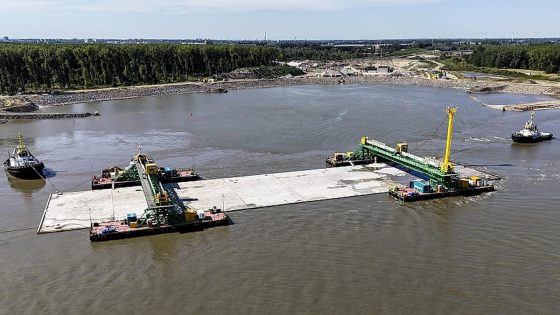The Oosterweel connection takes a giant leap forward as the first of eight massive tunnel sections is being submerged beneath the Schelde River. This milestone comes after years of preparation and marks a crucial phase in the construction of the Oosterweelverbinding, a project reshaping Antwerp’s infrastructure. On 2025-07-04 19:35:00, the operation to position the first 60,000-ton tunnel segment is underway, highlighting the complexity and scale of this billion-euro venture.
- Afzinken eerste tunneldeel Oosterweelverbinding gestart
- Tunneldeel weegt 60.000 ton, 160 meter lang
- Operatie vereist nauwkeurige positionering binnen 35 millimeter
- Tunnel bevat autoverkeer-, vlucht- en fietskokers
- Kostenproject stegen van 3,5 tot 10 miljard euro
- Publiek kan operatie vanaf Scheldedijk rechteroever volgen
Each tunnel segment, measuring 160 meters long and 42 meters wide, has been carefully transported from Zeebrugge to Antwerp. The delicate sinking process requires precise timing during dead tide to ensure minimal river current interference. But why has this project taken so long, and what does it mean for local commuters and cyclists?
As the first section is lowered into place, anticipation grows for the full tunnel’s completion, which promises improved mobility and greener urban spaces. Here’s a quick look at what this means for Belgium’s largest infrastructure project.
What challenges does this monumental project face, and how will it impact Antwerp’s future? The sinking operation is a technical feat requiring exact precision and timing. Key points include:
- The tunnel segments must be positioned within 35 millimeters of their planned location.
- Operations depend on dead tide to minimize river current, occurring only twice a month.
- The tunnel will feature separate tubes for cars, cyclists, and emergency escape routes.
- Costs have soared from €3.5 billion to over €10 billion, but benefits like reduced noise and improved air quality are expected to outweigh expenses.
With the first tunnel part in place, attention now turns to the remaining segments and their precise installation. Will the project stay on track for the 2028 cycling tunnel opening? Antwerp residents and commuters should stay informed and engaged as this transformative infrastructure unfolds.
































